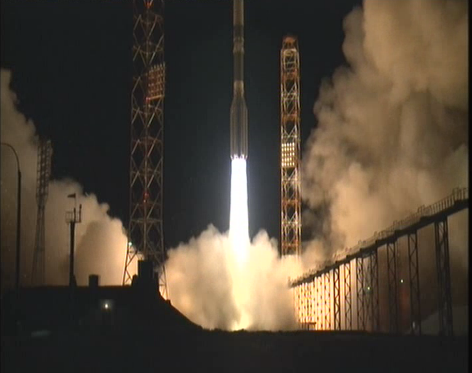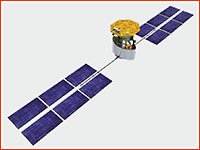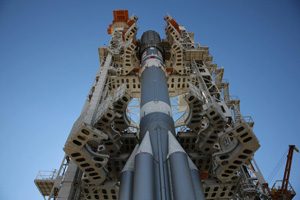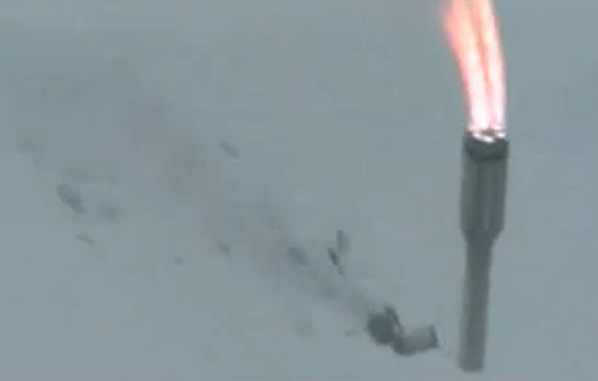
Under an unsurprising cloak of quietness, compared with earlier missions, a Proton-M booster has rocketed aloft from Baikonur Cosmodrome in Kazakhstan to deliver the Raduga-1M-3 military communications satellite directly into geostationary transfer orbit. Liftoff reportedly occurred at 5:46 a.m. local time Tuesday, 12 November (6:46 p.m. EST Monday, 11 November), and at the time of writing the nine-hour effort to inject the payload into its final orbital “slot,” via the restartable Briz-M upper stage, is nearing completion. In addition to providing television, telephone, and other services across the Eastern Hemisphere, Raduga-1M-3 will support communications between Russia’s armed forces and law enforcement organizations.
As described in yesterday’s mission preview article, this is the third member of the third generation of Raduga (“Rainbow”) satellites, whose heritage extends back almost four decades. Built by Information Satellite Systems (ISS) Reshetnev Company, within the closed city of Zheleznogorsk, near Krasnoyarsk in Russia’s northern Krasnoyarsk Krai, it is the product of an organization which has designed more than 1,000 satellites, including the GLONASS navigational network and the Ekspress geostationary communications constellation.

After gaining approval from the Central Committee of the Communist Party and the Council of Soviet Ministers in April 1972, a “dummy” Raduga mission—under the cover name of Cosmos 637—was launched into a 22,000-mile (35,500-km) geostationary orbit in March 1974. Less than two years later, in December 1975, Raduga-1 was placed into orbit to support the Orbita television network and provide uninterrupted, around-the-clock telephone and telegraph communications across the Soviet bloc and the Eastern Hemisphere. In addition to its outward civilian role, however, it carried a dedicated military transponder and it was not until many years later that its secret name of “Gran” (“Edge”) was revealed.
In its earliest incarnation, the basic 4,400-pound (2,000-kg) Raduga platform featured a three-axis-stabilized attitude control system, provided by gyroscopes and microthrusters, and its solar panels independently tracked the Sun, which avoided the need to adjust the satellite’s orientation. Following Raduga-1, subsequent launches came regularly throughout the 1970s and 1980s, with only a handful of failures. A Proton-K failed during first-stage flight in December 1982, causing the loss of Raduga-12, whilst both Raduga-33 and 34 were lost during second-stage Proton failures in February 1996 and July 1999. The most recent of these losses also marked the first attempted voyage by the Briz-M upper stage, which was flying in place of the Blok-DM utilized on earlier Proton/Raduga missions.
The second generation of satellites, known as “Raduga-1,” or “Globus,” began operations with an inaugural launch in June 1989. They featured C-band transponders for enhanced communications with fixed and mobile platforms. Seven subsequent missions flew from December 1990 until February 2009, by which time the current third generation had entered service. Today’s more modern “Raduga-1M” network saw its maiden launch atop a Proton-M/Briz-M in December 2007, with a second satellite following in January 2010. These are improved Globus satellites, featuring multi-transponder transmitters, whose centimeter- and decimeter-wave capabilities enable communications with mobile stations and hard-to-reach locations, including mountainous regions. Last night’s launch carried the third member of the Raduga-1M system into geostationary orbit. Weighing an estimated 5,500 pounds (2,500 kg), Raduga-1M-3 carries a pair of deployable solar arrays and batteries and should remain operational for about five years.

This year, 2013, has been a troubled one for the Proton-M. Following a dramatic launch failure on 2 July, seconds after liftoff—the Proton’s first mission to suffer a catastrophic malfunction during first-stage flight since the loss of Raduga-12 in December 1982—several months of corrective actions and scathing managerial and organizational changes were set in motion. In August, the Russian government formed the United Rocket and Space Corporation to consolidate the space sector, with Deputy Prime Minister Dmitri Rogozin announcing that it was “so troubled that it needs state supervision to overcome its problems.” A few weeks later, the Proton returned triumphantly to flight on 29 September, delivering the Astra 2E communications satellite into orbit, and secured its reliability credentials on 25/26 October by launching the Sirius FM-6 digital radio satellite.
All components of the Proton-M, including its three main stages and the restartable Briz-M upper stage, are fueled by a mixture of nitrogen tetroxide and unsymmetrical dimethyl hydrazine. Loading of these propellants aboard the Briz-M—whose single engine has the capacity to restart on multiple occasions and can support up to eight discrete firings to inject payloads into orbit—occurred during the final days ahead of launch, and the Russian State Commission formally granted approval for an early-morning rollout of the Proton to Launch Complex 81 at Baikonur on Friday, 8 November.
Fueling of the Proton’s three stages got underway about nine hours before liftoff. The rocket’s first stage consisted of a central oxidizer tank, surrounded by six outboard fuel tanks, each fed by an RD-276 engine, and these provided the initial impetus to boost the mission toward space. At T-5 minutes, the Briz-M upper stage was transferred to internal power and verified the health of its systems. Ignition of the six RD-276 engines commenced at T-2 seconds, ramping up to 100 percent of rated performance to produce 2.3 million pounds (1.04 million kg) of thrust at liftoff.
A little over a minute into the ascent, the Proton encountered a period of maximum aerodynamic stress (known as “Max Q”) on its flight surfaces, and the separation of the first stage occurred at the two-minute point. The vehicle’s second stage then picked up the baton, with its four engines generating a combined 540,000 pounds (244,950 kg) of propulsive yield for a little over 3.5 minutes. During this time, based on notes from the earlier Raduga-1M-1 and 1M-2 launch campaigns, the Russian Space Forces—who control and operate the satellites—initiated tracking of the vehicle. Soon after second-stage separation, the Payload Fairing (PLF) was jettisoned and the single-engine third stage added a further 138,000 pounds (62,600 kg) of thrust for the next four minutes of flight. Shutdown of the third stage occurred about 10 minutes after launch, by which time the vehicle was established on a suborbital trajectory.

The turn then came for the Briz-M, which has exhibited a mixture of success and failure since its maiden voyage. It was reported that separation of the Briz-M/Raduga-1M-1 combo from the third stage occurred about 15 minutes after launch. Capable of restarting up to eight times in flight, the Briz-M has a battery-powered lifetime of 24 hours and is believed to be flying a four-“burn” flight profile to place Raduga-1M-3 into orbit. These engine firings injected the satellite into a circular, low-Earth orbit of 105 x 105 miles (170 x 170 km), followed by subsequent burns which gradually expanded its apogee to 3,100 miles (5,000 km) and 22,100 miles (35,600 km), then established the payload into geostationary orbit. The Raduga should be in geostationary orbit about nine hours after launch—at about 2:47 p.m. Baikonur time (3:47 a.m. EST) Tuesday—and should communicate with ground stations shortly thereafter.
Speaking at the time of the launch of Raduga-1M-1 in December 2007, Vladimir Popovkin, then-commander of the Russian Space Forces and until recently head of the Russian Federal Space Agency, described the satellite as providing “communications for armed forces and other enforcement agencies, as well as in the interests of social development of our country.”
Want to keep up-to-date with all things space? Be sure to “Like” AmericaSpace on Facebook and follow us on Twitter: @AmericaSpace



